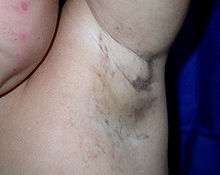Blaschko's lines
Blaschko's lines, also called the lines of Blaschko, named after Alfred Blaschko, are lines of normal cell development in the skin. These lines are invisible under normal conditions. They become apparent when some diseases of the skin or mucosa manifest themselves according to these patterns. They follow a "V" shape over the back, "S" shaped whirls over the chest, and sides, and wavy shapes on the head.[1]
The lines are believed to trace the migration of embryonic cells.[2][3] The stripes are a type of genetic mosaicism.[4] They do not correspond to nervous, muscular, or lymphatic systems. The lines can be observed in other animals such as cats and dogs.[5][6]
German dermatologist Alfred Blaschko is credited with the first demonstration of these lines in 1901.[7]
Conditions distributed along Blaschko's lines

The skin lesions that follow the Blaschko's lines are varied. They include genetic, congenital and acquired (i.e. non-genetic) conditions.[8] Examples include:
- Pigmentary disorders
- Naevus achromicus (including hypomelanosis of Ito)
- Epidermal Naevus
- X-linked genetic skin disorder
- Acquired inflammatory skin rashes
- Chimerism
See also
References
- ↑ Brown, Philip M (2002). Transcription. CRC Press. p. 38. ISBN 978-0-415-27200-1.
- ↑ Harper, John. Textbook of Pediatric Dermatology. p. 691. ISBN 0-86542-939-1.
- ↑ Ruggieri, Martino (2008). Neurocutaneous Disorders: Phakomatoses & Hamartoneoplastic Syndromes. Springer. p. 569. ISBN 978-3-211-21396-4.
- ↑ Roach, Ewell S (2004). Neurocutaneous Disorders. Cambridge University Press. p. 98. ISBN 978-0-521-78153-4.
- ↑ Muller, George & Kirk, Robert (2001). Muller & Kirk's small animal dermatology. Elsevier Health Sciences. p. 9. ISBN 978-0-7216-7618-0.
- ↑ Gross, Thelma Lee (2004). Veterinary Dermatopathology. Wiley-Blackwell. p. 156. ISBN 978-0-632-06452-6.
- ↑ Blaschko, Alfred (1901). Die Nervenverteilung in der Haut in ihre Beziehung zu den Erkrankungen der Haut.
- ↑ Bolognia JL, Orlow SJ, Glick SA (1994). "Lines of Blaschko". Journal of the American Academy of Dermatology. 31 (2): 157–190. doi:10.1016/S0190-9622(94)70143-1. PMID 8040398.
External links
- Humans Have Stripes
- Picture of the Blaschko's lines
- Illustrations of the various patterns of cutaneous mosaicism
- Understanding Genetics - ask a geneticist
- Description of Blaschko's lines